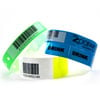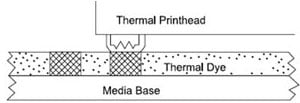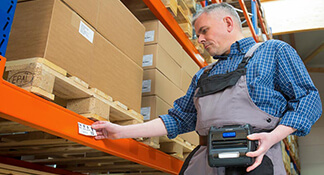Barcodes are used to track anything from retail products to patients to even military equipment. Selecting the proper media for the application can be confusing, due to the variety of material, adhesive, and size options. While a paper label may work perfectly for a standard product label, it would perform poorly in an application where you are attempting to tag an asset such as a vehicle. A more rugged plastic label would be more suitable for such an application. Moreover, sometimes labels might not be the right choice for your solution, as in the case of tracking patients with wristbands.
With the wide range of media types and materials available, it can be a challenge to decide on the best fit for your application. The first step in finding the right media is to identify your specific need(s):
• What are you tracking with barcodes? Products, people, equipment?
• How long will the label/tag/wristband be used?
• What kind of environment will the media be exposed to?
• What type of surface will the media attach to?
Knowing how you’ll be using barcode media will help you decide what type, material, and other features you’ll need. The following sections will help you understand the media buying process and determine the best media for your needs.
Media Types
The first step in choosing the right media is determining the correct form factor. While most applications will probably use an adhesive label, there are other media types that may be a better fit.
Labels
 When we refer to “labels” we are talking about the standard adhesive sticker-type media. All labels will have some kind of adhesive on them and are meant to apply directly to the asset. Labels are by far the most commonly used barcode media due to the simplicity to design and print, and the ease to which they are attached to the asset. Labels also come in a wide range of sizes and adhesive types to fit onto almost anything in any environment.
When we refer to “labels” we are talking about the standard adhesive sticker-type media. All labels will have some kind of adhesive on them and are meant to apply directly to the asset. Labels are by far the most commonly used barcode media due to the simplicity to design and print, and the ease to which they are attached to the asset. Labels also come in a wide range of sizes and adhesive types to fit onto almost anything in any environment.
Tags
 The main difference between a tag and a label is the tag’s lack of any adhesive. Tags are also made of a thicker stock than a label. One of the most common uses of tags is the clothing hang-tag. In any application where a smooth surface doesn’t exist, you can use other means like string or staples to attach a tag. Likewise, applications, where you need to remove the barcode from an item without leaving adhesive residue, will benefit from using a tag.
The main difference between a tag and a label is the tag’s lack of any adhesive. Tags are also made of a thicker stock than a label. One of the most common uses of tags is the clothing hang-tag. In any application where a smooth surface doesn’t exist, you can use other means like string or staples to attach a tag. Likewise, applications, where you need to remove the barcode from an item without leaving adhesive residue, will benefit from using a tag.
Wristbands
 Wristbands are a very specialized option for barcoding but also the best fit for the application of tracking people. You could always use a label on someone’s clothing but this will not be a reliable option since it’ll most likely fall off. A wristband is reliable and easy to use means to get a barcode on a person that will not fall off and handle the rigors of everyday life.
Wristbands are a very specialized option for barcoding but also the best fit for the application of tracking people. You could always use a label on someone’s clothing but this will not be a reliable option since it’ll most likely fall off. A wristband is reliable and easy to use means to get a barcode on a person that will not fall off and handle the rigors of everyday life.
Print Longevity – Print Method
Depending on how long you need your media to last, there are 2 varying print technologies from which to choose. The print method will determine how long the actual print on the media lasts.
Direct Thermal
 Direct thermal (DT) media does not use any kind of ink or ribbon to print. The media is coated with a heat-sensitive layer that changes color as it is exposed to the printer’s printhead. The printhead heats up and cools down according to your barcode design which is then imprinted into the media. Because the technology prints without a ribbon, direct thermal media is noted for its simplicity and lower overall cost. Direct thermal media have a considerable shelf life,(< 1 year), but is not well suited for environments exposed to heat, long periods of direct sunlight or abrasion. The printing on direct thermal media still produces sharp images with good scan ability. For any short-term application, like shipping labels, Direct Thermal is the most efficient option.
Direct thermal (DT) media does not use any kind of ink or ribbon to print. The media is coated with a heat-sensitive layer that changes color as it is exposed to the printer’s printhead. The printhead heats up and cools down according to your barcode design which is then imprinted into the media. Because the technology prints without a ribbon, direct thermal media is noted for its simplicity and lower overall cost. Direct thermal media have a considerable shelf life,(< 1 year), but is not well suited for environments exposed to heat, long periods of direct sunlight or abrasion. The printing on direct thermal media still produces sharp images with good scan ability. For any short-term application, like shipping labels, Direct Thermal is the most efficient option.
Thermal Transfer
 Thermal transfer media is not thermally coated and will require using a ribbon that is matched with the specific material type. In this case, the ribbon is essentially melted onto the media in the pattern of your barcode design. While thermal transfer media does use 2 consumables and is more costly upfront, the long-term benefit may result in cost savings over a direct thermal application. The thermal transfer media is not only impervious to heat and moisture, but the image can not be rubbed off, making the print the most durable, long-lived option. Since the color and density is determined by the ribbon and the printer’s resolution, this method produces consistent, reliable printing on every label. For any application that needs a long-lasting (> 1 year) and/or durable label, tag, or wristband, thermal transfer media will provide the most bang for your buck.
Thermal transfer media is not thermally coated and will require using a ribbon that is matched with the specific material type. In this case, the ribbon is essentially melted onto the media in the pattern of your barcode design. While thermal transfer media does use 2 consumables and is more costly upfront, the long-term benefit may result in cost savings over a direct thermal application. The thermal transfer media is not only impervious to heat and moisture, but the image can not be rubbed off, making the print the most durable, long-lived option. Since the color and density is determined by the ribbon and the printer’s resolution, this method produces consistent, reliable printing on every label. For any application that needs a long-lasting (> 1 year) and/or durable label, tag, or wristband, thermal transfer media will provide the most bang for your buck.
Material Type
Once you determine the type of media and the print method being used, the next step is to decide on the material to be used. There are 3 main types of materials that a label, tag, or wristband can be made of and each is best suited for different environments. Each material will use different ribbons (ink) as well when using thermal transfer printing. Making sure you use the right ribbon for the material type ensures you get the clearest and longest lasting print.
Paper: Wax Ribbon
Paper is the most commonly used material due to its low cost and ease of use. Most applications will be well served by paper-based media unless you are in a rugged or high moisture environment. Paper labels will tear and can get damaged but still can be an effective option for product, shipping, or any other indoor use applications. When using thermal transfer paper media you will need to use a wax ribbon.
Polypropylene: Wax/Resin Ribbon
Polypropylene is a plastic material that is the perfect solution for applications that require a more rugged material, while not being exposed to the outdoors or coming into contact with aggressive chemicals. Polypropylene is water resistant and will not tear. It is a great fit for asset labels since it will easily last the life of the item and is only a little more costly than paper. When using thermal transfer polypropylene media you will need to use a wax/resin ribbon.
Polyester: Resin Ribbon
Polyester is the most rugged of materials you can use and due to its much higher cost, is best for very extreme environments. Applications involving outdoor use, harsh conditions, or involve exposure to chemicals, will be best served by polyester. Polyester is about 5-6 times more costly than paper so it really should only be used when polypropylene or paper will not hold up. Vehicle tagging and chemical barrel labeling are examples when you would really need the durability of polyester. Polyester is very rarely available with a direct thermal option. When using thermal transfer polyester media you will need to use a full resin ribbon.
Media Material by Application
| Application | Paper: DT | Paper: TT | Polypropylene: DT | Polypropylene: TT | Polyester: TT |
|---|---|---|---|---|---|
| Asset labels (indoor) | • | • | |||
| Asset labels (outdoor) | • | ||||
| Shipping labels | • | ||||
| Product labels | • | ||||
| Shelf/Location tags | • | • | |||
| Wristbands (indoor) | • | ||||
| Wristbands (outdoor) | • | • | |||
| Clothing tags | • |
Adhesive Type
Adhesive is only a concern for labels since the other media types do not possess adhesive characteristics. While the vast majority of labels will use a standard permanent adhesive there are a couple options for more special cases.
Permanent
Most labels use an acrylic permanent adhesive that is great for smooth, clean surfaces. Once this adhesive fully bonds to the surface it will be difficult to remove and in the process, you will either destroy the label itself or leave a fair amount of residue at the very least. Permanent adhesive works well on paper, wood, glass, plastic, and some metals.
Removable
Removable adhesives do not have the same strength or stickiness as permanent adhesives, which make it easy to remove a label without damaging it or the item. Most often, a removable adhesive is used when a label is being used on paperwork during a process and then a product box when completed. Some specialty retails will also want to use this type of adhesive so that they can easily remove a pricing label without any residue on the item.
High Tack
High tack adhesive is a type of permanent adhesive that has extra initial stickiness. This type of adhesive is typically used in situations where you don’t have a clean, smooth surface at room temperature to apply the label. If you are using labels on site in a dirty environment like a building work site, a high tack adhesive would ensure the label bonds to the surface more quickly.
Additional Media Features
Although we have covered all the basic features you will need to determine to find the right media for most applications, there are a couple more options that are not as common but need to be addressed. These options may put your media choice into the realm of custom-made vs. stock, off-the-shelf option. Custom media may require extra lead times and can easily increase your overall cost of the solution.
Color
The vast majority of media is going to be blank white but a variety of colors are available. When a label or tag is colored it is referred to as “flood coated”. This just means that the entire surface is colored without any edge or border. There are often a few sizes of colored labels available off-the-shelf but if your required size is not available it will have to be custom made.
Special Shapes
Every stock label, tag, and wristband is going to be a rectangle or square. This is not to say that other shapes are not possible though. Some applications may want a circular label for easier identification or to fit on a bottle. There are some stock butterfly shaped labels for jewelry labeling but anything else beyond rectangular will always have to be custom made.
Finding the Right Barcode Labels and Ribbon
With all the options available for barcode media today, it can be a challenge to find the right device for your business. Determining the type, required longevity, and use environment will make deciding on a specific media easier. One thing to keep in mind is that each printer will have different rolls sizes it can accommodate that you’ll have to match up correctly. Feel free to call our media experts – we’re happy to help you find the right media for your printer and needs.
